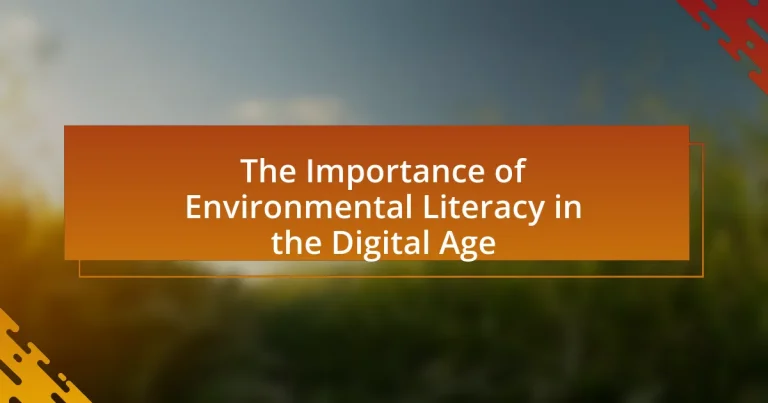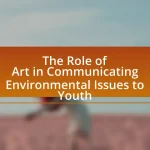Environmental literacy in the digital age is defined as the ability to understand and engage with environmental issues through digital tools and resources. This article explores the significance of environmental literacy, highlighting its key components, such as knowledge of ecological concepts, critical thinking skills, and civic engagement. It examines how technology enhances environmental literacy by providing access to information and interactive learning platforms, while also addressing challenges like misinformation and the digital divide. Furthermore, the article discusses the role of educators in promoting environmental literacy and the practical steps individuals can take to improve their understanding of environmental issues, ultimately emphasizing the importance of informed decision-making for sustainable development.
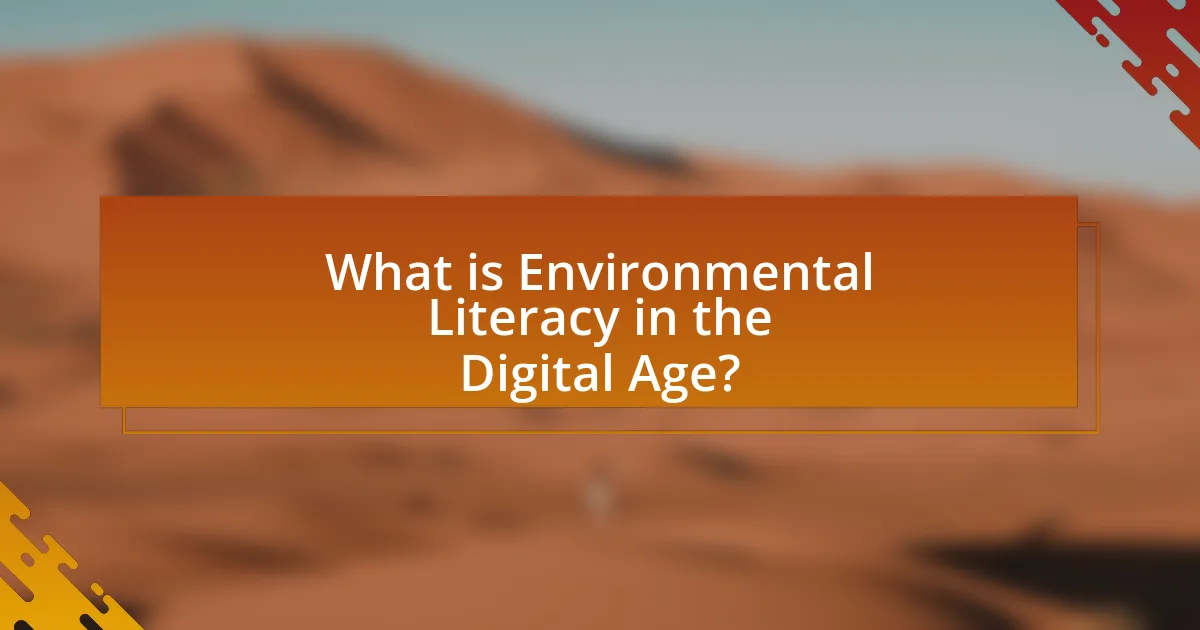
What is Environmental Literacy in the Digital Age?
Environmental literacy in the digital age refers to the ability to understand and engage with environmental issues using digital tools and resources. This includes accessing, analyzing, and communicating information about environmental challenges through various digital platforms, such as social media, online databases, and educational websites. Research indicates that digital literacy enhances individuals’ capacity to participate in environmental decision-making and advocacy, as evidenced by a 2020 study published in the Journal of Environmental Education, which found that students who utilized digital resources demonstrated a greater understanding of sustainability concepts compared to those who relied solely on traditional methods.
How is Environmental Literacy defined in contemporary contexts?
Environmental literacy in contemporary contexts is defined as the ability to understand and engage with environmental issues, integrating knowledge of ecological systems, sustainability, and the impact of human activities on the environment. This definition emphasizes critical thinking, problem-solving skills, and the capacity to make informed decisions regarding environmental stewardship. Research indicates that environmental literacy is essential for fostering responsible citizenship and promoting sustainable practices, as highlighted in the National Environmental Education Foundation’s report, which states that individuals with higher environmental literacy are more likely to engage in pro-environmental behaviors.
What are the key components of Environmental Literacy?
The key components of Environmental Literacy include knowledge of ecological concepts, awareness of environmental issues, skills for critical thinking and problem-solving, and the ability to engage in civic action. Knowledge of ecological concepts encompasses understanding ecosystems, biodiversity, and the interdependence of living organisms. Awareness of environmental issues involves recognizing challenges such as climate change, pollution, and resource depletion. Skills for critical thinking and problem-solving enable individuals to analyze information and develop solutions to environmental problems. Finally, the ability to engage in civic action empowers individuals to participate in decision-making processes and advocate for sustainable practices. These components collectively contribute to informed and responsible environmental stewardship.
How does technology influence our understanding of Environmental Literacy?
Technology enhances our understanding of Environmental Literacy by providing access to vast amounts of information and interactive tools that facilitate learning. Digital platforms, such as online courses and educational apps, allow individuals to engage with environmental concepts in real-time, promoting deeper comprehension. For instance, data visualization tools enable users to interpret complex environmental data, such as climate change statistics, making the information more accessible and actionable. Additionally, social media campaigns raise awareness and foster community engagement around environmental issues, demonstrating the power of technology in mobilizing collective action. Research indicates that individuals who utilize technology for environmental education are more likely to adopt sustainable practices, underscoring the significant role technology plays in shaping environmental literacy.
Why is Environmental Literacy crucial in today’s society?
Environmental literacy is crucial in today’s society because it empowers individuals to understand and address environmental challenges effectively. As climate change, pollution, and biodiversity loss escalate, informed citizens are essential for promoting sustainable practices and policies. Research indicates that environmental literacy enhances critical thinking and decision-making skills, enabling people to engage in meaningful discussions about ecological issues. For instance, a study by the National Environmental Education Foundation found that individuals with higher environmental literacy are more likely to participate in conservation efforts and advocate for environmental protection. This connection between knowledge and action underscores the importance of fostering environmental literacy in educational systems and communities.
What role does Environmental Literacy play in sustainable development?
Environmental literacy plays a crucial role in sustainable development by equipping individuals with the knowledge and skills necessary to make informed decisions regarding environmental issues. This understanding fosters responsible behavior towards natural resources, promoting practices that support ecological balance and sustainability. Research indicates that higher levels of environmental literacy correlate with increased participation in sustainable practices, such as recycling and conservation efforts. For instance, a study published in the Journal of Environmental Education found that students with strong environmental literacy were more likely to engage in pro-environmental behaviors, demonstrating the direct impact of education on sustainability outcomes.
How does Environmental Literacy impact individual and community actions?
Environmental literacy significantly influences individual and community actions by enhancing awareness and understanding of environmental issues, leading to more sustainable behaviors. Individuals who are environmentally literate are more likely to engage in practices such as recycling, conserving energy, and supporting sustainable products, as evidenced by a study from the National Environmental Education Foundation, which found that 70% of environmentally literate individuals actively participate in eco-friendly activities. Communities benefit from this literacy as well, as it fosters collective initiatives like community gardens and clean-up events, which are shown to improve local ecosystems and community cohesion. Thus, environmental literacy serves as a catalyst for both personal responsibility and community engagement in sustainability efforts.
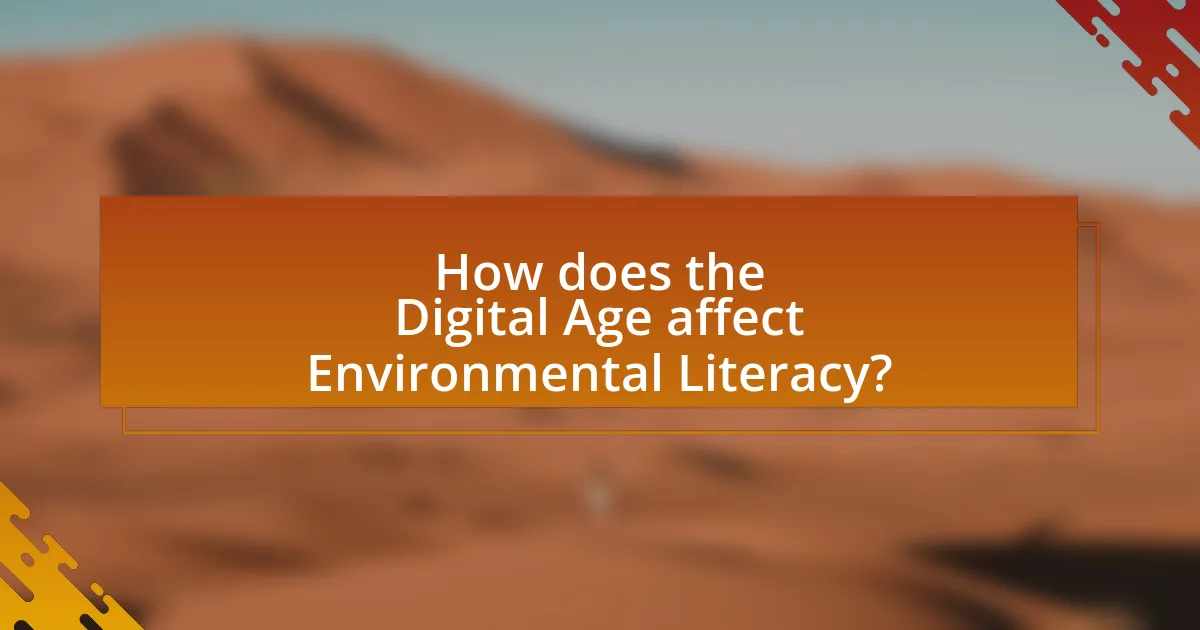
How does the Digital Age affect Environmental Literacy?
The Digital Age enhances Environmental Literacy by providing widespread access to information and educational resources. Digital platforms facilitate the dissemination of environmental knowledge through online courses, social media campaigns, and interactive tools, making it easier for individuals to learn about sustainability and ecological issues. For instance, a study by the Pew Research Center found that 87% of adults in the U.S. use the internet, which allows them to engage with environmental content and participate in discussions. This increased access to information empowers individuals to make informed decisions regarding environmental practices and policies, ultimately fostering a more environmentally literate society.
What digital tools enhance Environmental Literacy?
Digital tools that enhance Environmental Literacy include interactive educational platforms, mobile applications, and online databases. Interactive platforms like EcoExplorer and Earth Rangers provide engaging content that helps users understand environmental issues through gamification and real-world applications. Mobile applications such as iNaturalist and PlantNet allow users to identify species and contribute to biodiversity data, fostering a deeper connection to nature. Online databases like the Global Biodiversity Information Facility (GBIF) offer access to extensive datasets that support research and education on environmental topics. These tools collectively promote awareness and understanding of environmental challenges, thereby improving environmental literacy.
How do social media platforms contribute to environmental awareness?
Social media platforms contribute to environmental awareness by facilitating the rapid dissemination of information related to environmental issues. These platforms enable users to share articles, videos, and personal experiences, which can reach a global audience quickly. For instance, campaigns like #FridaysForFuture have mobilized millions to advocate for climate action, demonstrating the power of social media in raising awareness and fostering community engagement. Research indicates that social media can significantly influence public perception and behavior regarding environmental sustainability, as seen in studies showing increased participation in eco-friendly initiatives following viral posts about climate change.
What role do educational apps play in promoting Environmental Literacy?
Educational apps play a crucial role in promoting Environmental Literacy by providing interactive and engaging platforms for users to learn about environmental issues and sustainable practices. These apps often incorporate gamification, quizzes, and multimedia content, which enhance user engagement and retention of information. For instance, a study published in the Journal of Environmental Education found that students using educational apps demonstrated a 30% increase in knowledge retention regarding environmental concepts compared to traditional learning methods. This evidence highlights the effectiveness of educational apps in fostering a deeper understanding of environmental literacy among users.
How can misinformation in the digital space hinder Environmental Literacy?
Misinformation in the digital space can significantly hinder Environmental Literacy by spreading false or misleading information about environmental issues. This distortion can lead to public confusion, resulting in a lack of understanding of critical concepts such as climate change, biodiversity, and sustainability. For instance, a study published in the journal “Environmental Communication” found that misinformation can create polarized views on environmental policies, making it difficult for individuals to engage in informed discussions or take appropriate actions. Consequently, when people are exposed to inaccurate information, their ability to make educated decisions regarding environmental practices is compromised, ultimately undermining efforts to promote environmental awareness and action.
What are common misconceptions about environmental issues online?
Common misconceptions about environmental issues online include the belief that climate change is a hoax, that recycling alone can solve environmental problems, and that individual actions have no impact on larger environmental issues. Climate change is supported by overwhelming scientific consensus, with organizations like the Intergovernmental Panel on Climate Change reporting significant human contributions to global warming. The idea that recycling can single-handedly address environmental degradation overlooks the need for systemic changes in production and consumption patterns, as highlighted by the Ellen MacArthur Foundation, which emphasizes the importance of a circular economy. Lastly, while individual actions are often seen as insignificant, studies show that collective behavior changes can lead to substantial environmental benefits, as demonstrated by the success of community-led sustainability initiatives.
How can critical thinking skills mitigate the effects of misinformation?
Critical thinking skills can mitigate the effects of misinformation by enabling individuals to analyze, evaluate, and synthesize information critically. This analytical process allows individuals to discern credible sources from unreliable ones, reducing the likelihood of accepting false information as truth. Research indicates that individuals with strong critical thinking abilities are better equipped to question the validity of claims, recognize logical fallacies, and seek evidence before forming conclusions. For instance, a study published in the Journal of Educational Psychology found that students trained in critical thinking demonstrated a significant improvement in their ability to assess the credibility of online information, thereby decreasing their susceptibility to misinformation.
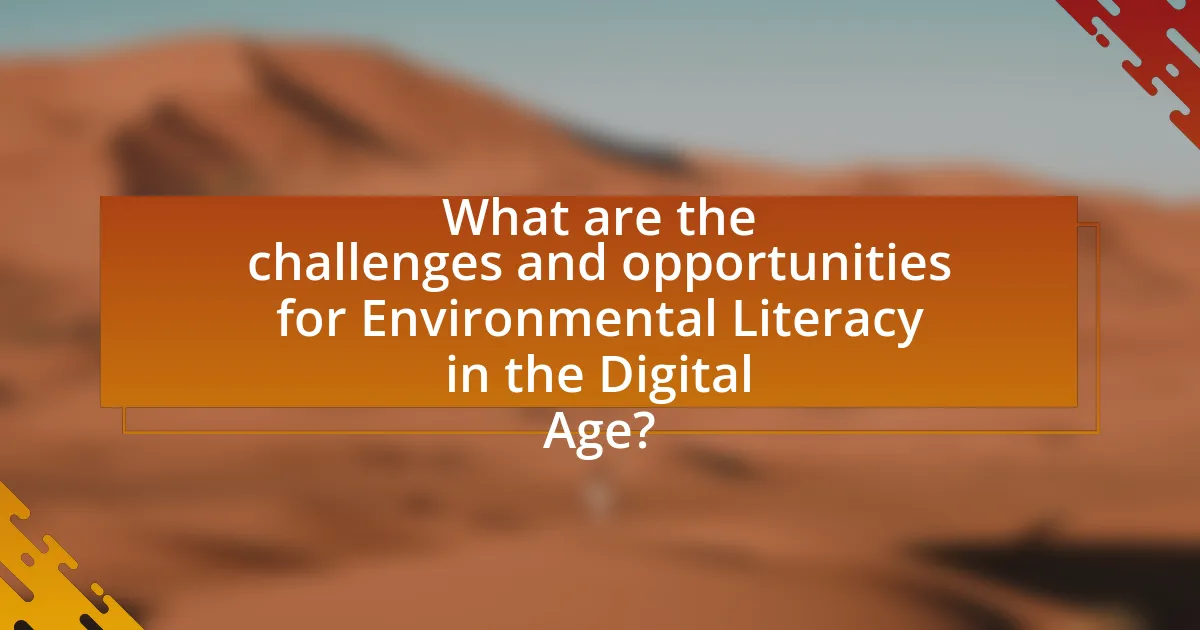
What are the challenges and opportunities for Environmental Literacy in the Digital Age?
The challenges for Environmental Literacy in the Digital Age include misinformation, digital divide, and information overload. Misinformation can spread rapidly through social media, leading to misconceptions about environmental issues. The digital divide creates disparities in access to information, leaving marginalized communities without the resources needed for environmental education. Information overload can overwhelm individuals, making it difficult to discern credible sources and actionable insights.
Conversely, opportunities for Environmental Literacy in the Digital Age are enhanced access to information, interactive learning platforms, and global connectivity. The internet provides vast resources for environmental education, allowing individuals to learn from diverse perspectives. Interactive platforms, such as online courses and simulations, engage users in environmental issues more effectively. Global connectivity enables collaboration and sharing of best practices across borders, fostering a collective approach to environmental challenges.
What challenges do educators face in teaching Environmental Literacy digitally?
Educators face several challenges in teaching Environmental Literacy digitally, including limited access to technology, varying levels of digital literacy among students, and the difficulty of engaging students in complex environmental issues through online platforms. Limited access to technology can hinder students’ ability to participate fully in digital learning environments, as approximately 15% of U.S. households lack internet access, according to the Federal Communications Commission. Additionally, educators must navigate the diverse digital literacy skills of their students, which can lead to disparities in understanding and engagement. Furthermore, conveying the intricacies of environmental issues through digital mediums often lacks the interactive and experiential learning opportunities that in-person education provides, making it harder for students to connect with the material.
How can educators overcome barriers to effective digital teaching?
Educators can overcome barriers to effective digital teaching by implementing targeted professional development and leveraging technology to enhance engagement. Professional development programs focused on digital pedagogy equip educators with the necessary skills to navigate digital tools effectively, as evidenced by a study from the International Society for Technology in Education, which found that 78% of teachers reported improved confidence in using technology after such training. Additionally, utilizing interactive platforms and resources can foster student engagement, addressing the common barrier of student motivation in digital environments. By combining these strategies, educators can create a more effective and inclusive digital teaching experience.
What resources are available to support educators in this effort?
Educators can access various resources to support their efforts in promoting environmental literacy in the digital age. These resources include online platforms such as the National Environmental Education Foundation, which offers curriculum guides and professional development opportunities specifically designed for educators. Additionally, organizations like Project Learning Tree provide comprehensive lesson plans and activities that integrate environmental education into existing curricula. Research indicates that integrating technology in environmental education enhances student engagement and understanding, as shown in studies published by the Journal of Environmental Education, which highlight the effectiveness of digital tools in teaching complex environmental concepts.
What opportunities exist for enhancing Environmental Literacy through technology?
Opportunities for enhancing Environmental Literacy through technology include the use of interactive digital platforms, mobile applications, and online educational resources. These technologies facilitate access to real-time environmental data, enabling users to engage with and understand ecological issues more effectively. For instance, platforms like NASA’s Earth Observing System Data and Information System provide satellite imagery and data that help users visualize climate change impacts. Additionally, mobile apps such as iNaturalist encourage citizen science by allowing users to document and share biodiversity observations, fostering a deeper connection to local ecosystems. Research indicates that technology-driven educational tools can significantly improve knowledge retention and engagement in environmental topics, as evidenced by studies showing increased student performance in environmental science courses when utilizing digital resources.
How can virtual reality experiences foster a deeper understanding of environmental issues?
Virtual reality experiences can foster a deeper understanding of environmental issues by immersing users in realistic simulations that illustrate the impact of human actions on ecosystems. These immersive environments allow individuals to visualize complex environmental processes, such as climate change, deforestation, and pollution, in a way that traditional educational methods cannot achieve. For instance, studies have shown that participants in virtual reality simulations of coral reef degradation reported increased awareness and concern for marine conservation, highlighting the effectiveness of experiential learning in promoting environmental literacy. By engaging users emotionally and cognitively, virtual reality can enhance empathy towards environmental challenges, ultimately motivating proactive behavior and informed decision-making regarding sustainability.
What collaborative platforms can promote community engagement in environmental education?
Collaborative platforms that can promote community engagement in environmental education include social media networks, online forums, and educational websites. Social media platforms like Facebook and Instagram facilitate the sharing of environmental initiatives and educational content, reaching a broad audience and encouraging community discussions. Online forums such as Reddit or specialized environmental forums allow users to exchange ideas, share resources, and collaborate on projects. Educational websites like Coursera and EdX offer courses that foster community interaction through discussion boards and group projects, enhancing collective learning experiences. These platforms have been shown to increase participation and awareness in environmental issues, as evidenced by studies indicating that social media campaigns can significantly raise public engagement in environmental topics.
What practical steps can individuals take to improve their Environmental Literacy?
Individuals can improve their Environmental Literacy by actively engaging in educational resources, participating in community initiatives, and practicing sustainable habits. Engaging with educational resources includes reading books, articles, and research studies on environmental issues, which enhances knowledge and awareness. Participating in community initiatives, such as local clean-up events or conservation projects, fosters a practical understanding of environmental challenges and solutions. Practicing sustainable habits, like reducing waste, conserving energy, and supporting eco-friendly products, reinforces the principles of environmental stewardship. According to a study published in the Journal of Environmental Education, individuals who participate in hands-on environmental activities demonstrate a significant increase in their environmental knowledge and attitudes, highlighting the effectiveness of these practical steps.
How can one utilize online resources to enhance personal knowledge of environmental issues?
One can utilize online resources to enhance personal knowledge of environmental issues by engaging with educational websites, online courses, and digital libraries that focus on environmental science and sustainability. For instance, platforms like Coursera and edX offer courses from reputable universities on topics such as climate change, biodiversity, and renewable energy, allowing individuals to learn from experts in the field. Additionally, websites like the Environmental Protection Agency (EPA) and the World Wildlife Fund (WWF) provide up-to-date information, research reports, and educational materials that can deepen understanding of current environmental challenges. Research indicates that online learning can significantly improve knowledge retention and engagement, making these resources effective tools for personal education on environmental issues.
What are effective strategies for engaging with local environmental initiatives?
Effective strategies for engaging with local environmental initiatives include participating in community clean-up events, joining local environmental organizations, and advocating for sustainable practices within local government. Community clean-up events foster direct involvement and visibly improve local environments, while joining organizations provides networking opportunities and access to resources. Advocacy efforts, such as attending town hall meetings, can influence policy changes that support environmental sustainability. Research indicates that community engagement in environmental initiatives leads to increased awareness and action, as seen in studies like “Community Engagement in Environmental Sustainability” by the University of California, which highlights the positive correlation between local participation and environmental outcomes.
